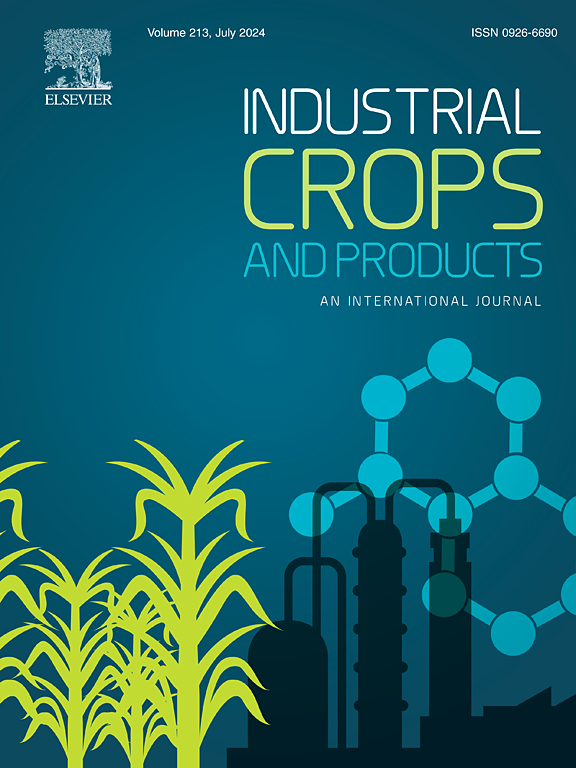Drip-applied rhamnolipid ameliorates soil physicochemical properties and enhances cotton yield under dry sowing with wet emergence cultivation
IF 6.2
1区 农林科学
Q1 AGRICULTURAL ENGINEERING
引用次数: 0
Abstract
Water scarcity and soil salinization are pivotal challenges constraining the sustainable development of the cotton industry. The synergetic application of dry sowing with wet emergence irrigation technology and rhamnolipid mediated technology has shown remarkable potential in reducing pre-sowing water requirements and mitigating soil salinity, while concurrently enhancing cotton growth and yield formation. This study investigates the impact of three irrigation frequencies high (F3), medium (F5), and low (F7) and three rhizomiclipid concentrations 0 (CK), 200 (RL), and 400 mg ·L−1 (RH) on soil physicochemical properties, cotton emergence rates, and yields under dry sowing with wet emergence irrigation conditions (DSWE). The results demonstrate that irrigation frequency and rhamnolipid concentration significantly influence soil characteristics and cotton growth (P < 0.05). Specifically, under dry sowing with wet emergence irrigation conditions with a 5-day irrigation interval (F5) and 200 mg ·L−1 rhamnolipid concentration (RL), soil salinity indicators such as electrical conductivity (EC) and pH, along with sodium ion (Na+) content, were substantially reduced. Concurrently, soil potassium ion (K+) content and enzymatic activities, including catalase (CAT), alkaline phosphatase (AKP), sucrase (SC), and urease (UE), were notably elevated. These modifications contributed to enhanced cotton emergence rates and increased yields. The partial least squares path modeling (PLS-PM) analysis demonstrated that both irrigation frequency and rhamnolipid (RL) drip concentration could directly and significantly affect the soil environment, which in turn directly or indirectly influenced cotton germination rate, biomass, and yield. This research underscores the potential of integrating dry sowing with wet emergence irrigation with rhamnolipid applications to address water scarcity, achieve high water-use efficiency in cotton cultivation, and support sustainable agricultural practices. The findings provide both theoretical underpinnings and practical guidance for advancing water-efficient and sustainable cotton production systems.
滴施鼠李糖脂可改善干播湿苗栽培条件下土壤理化性质,提高棉花产量
水资源短缺和土壤盐渍化是制约棉花产业可持续发展的关键问题。干播与湿出苗灌溉技术和鼠李糖脂介导技术协同应用,在减少播前需水量和降低土壤盐分方面显示出显著的潜力,同时促进棉花生长和产量形成。研究了干播湿出苗灌溉条件下,高(F3)、中(F5)、低(F7)三种灌溉频率和根际脂质浓度分别为0 (CK)、200 (RL)和400 mg ·L−1 (RH)对土壤理化性质、棉花出苗率和产量的影响。结果表明,灌溉频率和鼠李糖脂浓度对土壤特性和棉花生长有显著影响(P <; 0.05)。具体而言,在干播、湿出苗、灌溉间隔5天(F5)、鼠李糖脂浓度(RL)为200 mg ·L−1的条件下,土壤电导率(EC)、pH等盐分指标以及钠离子(Na+)含量均显著降低。同时,土壤钾离子(K+)含量和过氧化氢酶(CAT)、碱性磷酸酶(AKP)、蔗糖酶(SC)和脲酶(UE)活性显著升高。这些改良有助于提高棉花出苗率和产量。偏最小二乘路径模型(PLS-PM)分析表明,灌溉频率和鼠李糖脂(RL)滴灌浓度对土壤环境有直接而显著的影响,进而直接或间接影响棉花发芽率、生物量和产量。这项研究强调了将干播、湿苗灌溉与鼠李糖脂应用相结合的潜力,以解决水资源短缺问题,实现棉花种植的高用水效率,并支持可持续农业实践。研究结果为推进节水和可持续棉花生产系统提供了理论基础和实践指导。
本文章由计算机程序翻译,如有差异,请以英文原文为准。
求助全文
约1分钟内获得全文
求助全文
来源期刊

Industrial Crops and Products
农林科学-农业工程
CiteScore
9.50
自引率
8.50%
发文量
1518
审稿时长
43 days
期刊介绍:
Industrial Crops and Products is an International Journal publishing academic and industrial research on industrial (defined as non-food/non-feed) crops and products. Papers concern both crop-oriented and bio-based materials from crops-oriented research, and should be of interest to an international audience, hypothesis driven, and where comparisons are made statistics performed.
 求助内容:
求助内容: 应助结果提醒方式:
应助结果提醒方式:


